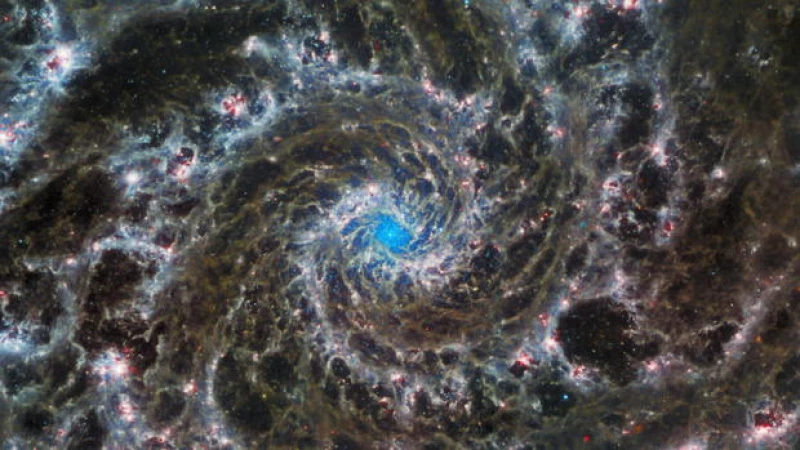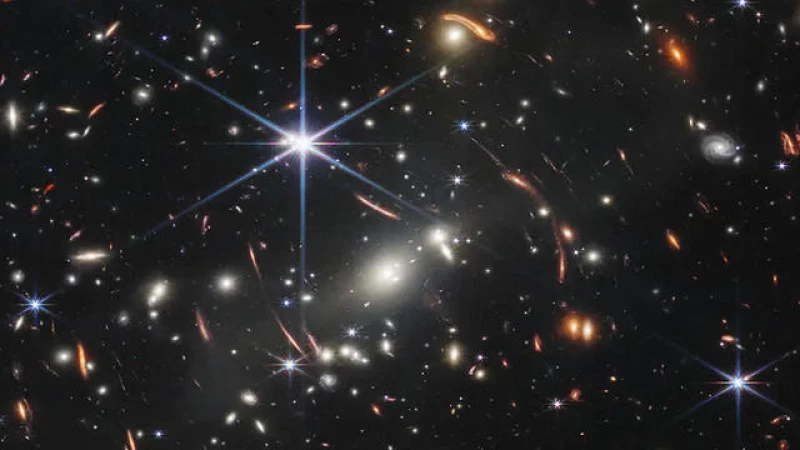Christmas is not only a time for miracles on Earth, but also in the skies above. Two years ago, on Christmas Day, the James Webb Space Telescope embarked on its journey, bringing us an abundance of new and miraculous visions from the cosmos.

Unlike its predecessor, the Hubble Telescope, the James Webb Space Telescope is equipped with massive gold-plated lenses that can detect infrared light. This allows it to see beyond what our eyes can perceive, penetrating dust and gases, and reaching 100 times farther into the universe.
Not only is the Webb technologically superior, but it is also physically larger. Standing three stories tall and measuring 70 feet wide, it is too big to fit into any existing rocket. To overcome this challenge, NASA came up with an ingenious solution – folding it up.
Scott Willoughby, who oversaw the construction of the Webb at Northrup Grumman, explained the complexity of the unfolding process. With over 300 single-point failures, each with its own unique movement requirement, the unfolding of the Webb is a delicate and intricate operation.
Thanks to the Webb, we have been able to witness breathtaking sights from the far reaches of our universe. From the majestic rings of Jupiter, a mere 385 million miles away, to the ethereal beauty of the Carina Nebula, located 7,500 light-years from Earth. We have even ventured further into the cosmos, capturing images of the Phantom Galaxy, which lies 32 million light-years away, and delving into the deepest regions of space, a staggering 13 billion light-years from our planet.
Three Hundred Things That Had to Go Right
It took almost seven months for the telescope to unfold, calibrate, and reach its orbit, a million miles from Earth. So now, on the second anniversary of the launch, we asked how it went.
"It literally went perfect, as close to perfect as one could've even imagined," a spokesperson said. "People actually asked after, 'Did you overblow how hard this was?' And the truth was, practicing for everything as if it could go wrong was the best preparation for making it go right."
Because infrared is a form of heat, it had to get cold—minus 400 degrees. Even the sun's heat would blind the telescope to the faint infrared signals from space. And so, a large sun shield – an umbrella, basically – was deployed to block out any shred of the sun's light from reaching the telescope's lenses. "There's only one star in the entire universe we'll never see, and it's ours, it's the sun," the spokesperson said.
Finally, the science could begin.
- The James Webb Space Telescope: Looking back towards the beginning of time ("Sunday Morning")
At NASA's Space Telescope Science Institute in Baltimore, the chief scientist of the Webb Telescope, Jane Rigby, communicates with the telescope from the flight control room to extract the collected data. Rigby stated, "The main objective of the Webb Telescope was to capture the earliest images of the universe. We have successfully accomplished that goal. We have transitioned from a state of ignorance about the first billion years of the universe to having a clear and detailed understanding."
Another significant objective of the Webb Telescope is to examine distant planets and determine if any of them possess atmospheres similar to Earth's, potentially identifying a planet suitable for human habitation. However, how can a telescope discern the composition of a planet's atmosphere from such a distance? It turns out that when a planet passes in front of its star, the elements within its atmosphere, such as oxygen and nitrogen, block specific wavelengths of light. Analyzing the changes in the spectrum of light can reveal valuable information about the atmosphere of that planet.
The Webb Telescope has already investigated the atmospheres of numerous distant planets. For instance, on the exoplanet K2-18 b, located a mere 120 light-years away from Earth, the telescope detected the presence of carbon dioxide and methane, indicating the potential existence of oceans.
Rigby expressed her delight in the successful operation of the telescope, stating, "It is truly a joy to witness the exceptional performance of this telescope, as it was meticulously engineered by a talented team of professionals."
However, not all headlines regarding the Webb Telescope have been positive. In June 2022, one headline raised concerns.
Despite the impact, Scott Willoughby, the designer of the mirrors, remained unconcerned. He explained that the mirrors were specifically designed to withstand micrometeoroid hits, even in small spots on a large surface. He assured that the impact had no impact on the telescope's scientific capabilities.
- Webb telescope still performing well after micrometeoroid impact on mirror segment, NASA says
- Webb telescope captures cluster of baby stars in the center of the Milky Way
- James Webb Space Telescope makes "surprising" discovery in halo of dying star
- Unprecedented Webb telescope image reveals "new feature" in famous supernova
- James Webb Space Telescope captures spectacular image of nearby stellar nursery
However, there were some concerns about the authenticity of the telescope's photos. NASA image experts Joe DePasquale addressed the issue, stating that it is a common question whether the images captured by Webb are real. DePasquale and Alyssa Pagan, the experts responsible for colorizing the images, explained that their role is to translate the light captured by the telescope into something visible to the human eye.
They emphasized that there are types of light, such as ultraviolet and infrared, that are not visible to the naked eye. Bees, for example, can see ultraviolet light, while pit vipers can see infrared light. The colorizing process takes into account the different wavelengths of light to create visually appealing images.
Pagan explained, "By assigning the shortest wavelengths to the bluer color, the middle wavelength to the green color, and the longest wavelength to the red color, we believe we have achieved the most accurate representation of what we would see if we were able to perceive infrared light."

In just its first year of operation, the Webb telescope has already resulted in over 600 scientific papers. And as Willoughby reveals, the telescope has one more surprise in store for us this Christmas: "When we launched, we didn't have to make any corrections to our rocket engines. This allowed us to save all of that fuel, effectively doubling the duration of the mission from ten years to twenty."
So, for at least the next two decades, scientists from all over the world will continue unraveling the mysteries of the universe, while the Webb telescope continues to capture and transmit astonishing images, ranging from the peculiar optical phenomenon known as "the question mark" to the galaxy cluster affectionately referred to as the "Christmas Tree" by NASA, and beyond.
For more information:
Story produced by Young Kim. Editor: Karen Brenner.







